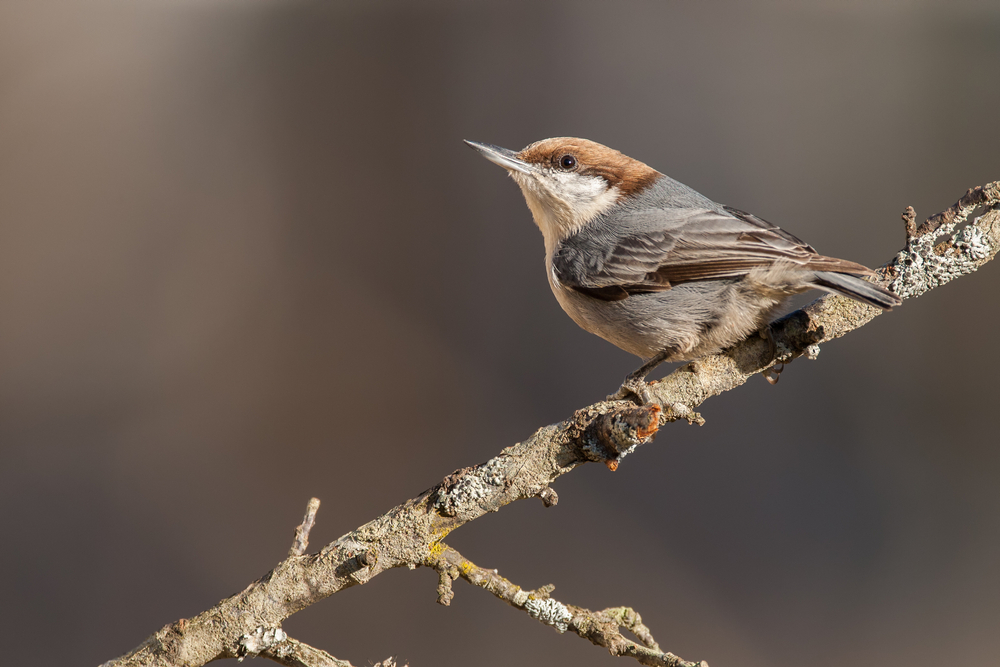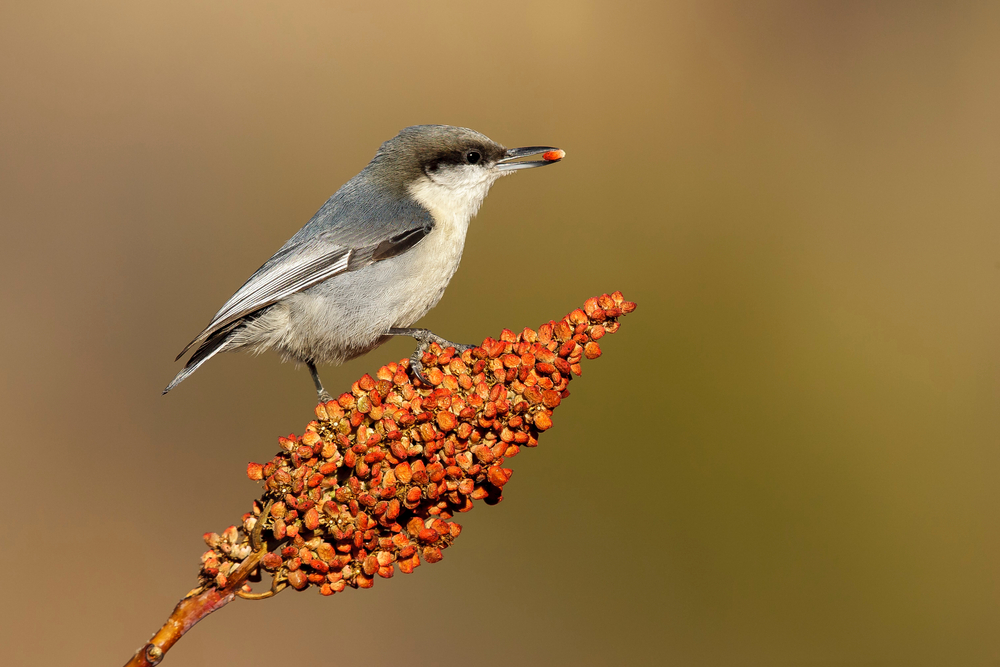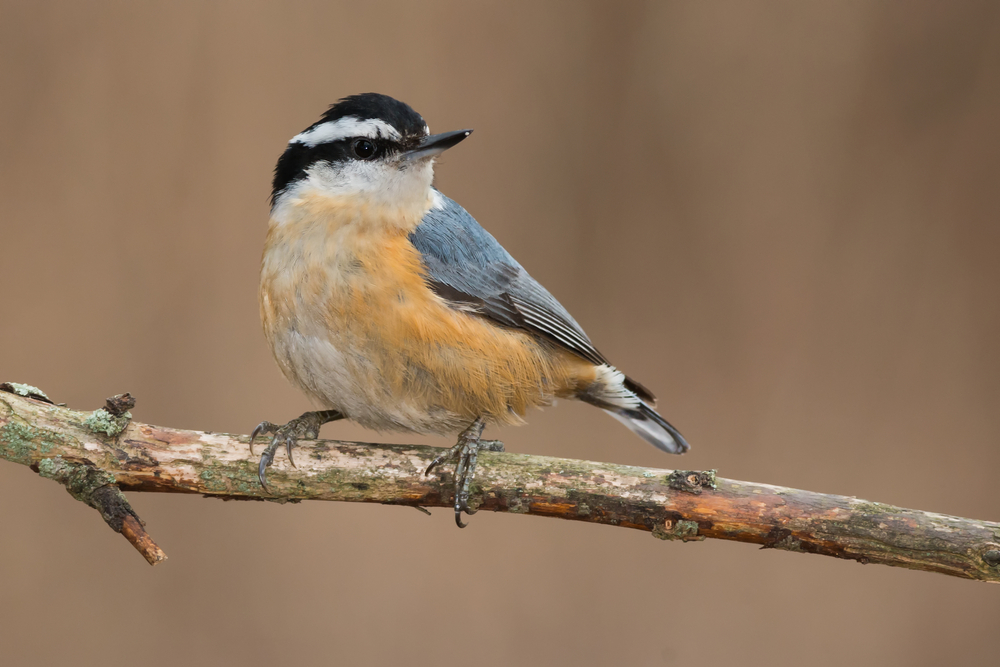There are 4 species of nuthatches found in North America-the red-breasted nuthatch, the white-breasted nuthatch, the brown-headed nuthatch, and the pygmy nuthatch. While they have distinct physical features, these tree-climbing birds share habitat, food, nesting, and foraging behaviors in common.
The 4 species of nuthatch found in North America share several similarities. Because each species overlaps with at least one other species of nuthatch, location alone won’t tell you what type of nuthatch you have at your backyard bird feeder. Luckily these delightful North American birds have distinct physical appearances to help you tell the difference between them.
We’ll cover the similarities between the 4 types of nuthatches, as well as the differences. We’ll also share interesting facts about each species of nuthatch. Use these tips to tell them about, and you’ll be in the know about nuthatches!
What do the 4 species of nuthatch have in common?
All 4 species of nuthatch found in North America share food, habitat, foraging, and nesting behaviors. All nuthatches are cavity nesters who live in forests. These small birds forage for insects in tree bark. Nuthatches will also store excess food in tree bark crevices to eat later.
Nuthatches in North America are part of the family Sittidae. There are over two dozen species of nuthatches worldwide. While the nuthatch birds of the world are quite diverse in their looks, all Sittidae family birds have a few things in common:
- Large heads
- Short tails
- Long claws for hanging upside down
- Strong beaks
- They are all tree climbers
- They are omnivores
- All nuthatches nest in natural cavities
Bird watchers sometimes call nuthatches the upside-down bird. This quirky species of bird will forage while clinging to branches with its long toes. They have also been known to climb down trees head first!
How can I tell a red-breasted nuthatch apart from other species of nuthatches?
The red-breasted nuthatch has black and white eye lines and dark wings. Unlike the other nuthatch species, the red-breasted nuthatch’s underparts are reddish brown. The female red-breasted nuthatch has slightly lighter underparts that are a soft tawny brown.
Of all the species of nuthatch, the red-breasted nuthatch is the only one with the black cap, white eyebrow line, and black eye line pattern combination. The pattern is similar to a badger, giving the red-breasted nuthatch a very distinct look. The female red-breasted nuthatch is almost identical, but her colors are muted.
The red-breasted nuthatch (Sitta canadensis) range is largest during the non-breeding season when they can be in fact be found in almost every state in America (except Hawaii) and much of Canada. The rest of the year, the red-breasted nuthatch lives in higher elevations and mountainous regions. Large populations of red-breasted nuthatches can be found throughout the year in the Rocky Mountains and the Appalachian Mountains.
Red-breasted nuthatches favor coniferous forests. They have one of the more creative ways of protecting their nest cavity from predators. Red-breasted nuthatches spread coniferous tree sap around the entrance hole to their nest. The result is a sticky trap that keeps predators from getting too close!
How do you identify a white-breasted nuthatch?
The white-breasted nuthatch has a black cap and shoulders with bluish gray feathers on its wings and short tail. The underparts are white, with a small bit of rust brown feathering under the tail. The female white-breasted nuthatch looks like the male but has a gray cap on her head.
This nuthatch species has black feathers mixed with predominantly gray wings and tails. The soft gray patch around the cheek and eye blends almost entirely with the white underside. Despite being gray, white, and black, this small bird’s color is quite striking. Even the gray feathers are bright with a hint of blue.
The white-breast nuthatch (Sitta carolinensis) is found in all 48 contiguous United States and on both sides of the southern US-Canadian border. Unlike the red-breasted nuthatch, the white-breasted nuthatch also extends into a good portion of central Mexico. The range doesn’t change much, shifting slightly into warmer parts of North Texas, Oklahoma, Kansas, and Nebraska during the wintertime.
The white-breasted nuthatch favors deciduous forests. They eat acorns, which they will store in tree bark crevices for later. Once the acorn is firmly lodged in the tree bark, they will use their strong beaks to hammer the acorn nut from the shell.

What does a brown-headed nuthatch look like?
The brown-headed nuthatch has a brown cap on its head and a slightly darker brown eye line. The chin is white, and the underparts and shoulders are soft gray. The brown-head nuthatch has slate gray wings with brown feathers mixed in. The female brown-headed nuthatch is similar in color, with more delicate gray and brown markings than the male.
The brown-headed nuthatch (Sitta pusilla) range is much smaller than white-breasted and red-breasted nuthatches. Brown-headed nuthatches are found year-round in east Texas, the southeast corner of Oklahoma, Louisiana, Alabama, Mississippi, Florida, Georgia, the Carolinas, and around the Chesapeake Bay area. Some brown-headed nuthatches have settled in the Bahamas but were reclassified in 2021 as the Bahama Nuthatch (Sitta insularis).
Brown-headed nuthatches live in pine forests and have a very unique song. The Cornell Lab of Ornithology compares the song of the brown-headed nuthatch to a rubber ducky. The two-note squeak is repeated up to a dozen times per cycle!
The brown-headed nuthatch is one of the few small birds observed using tools! This intelligent bird species uses tree bark as a prying tool. They will even carry a particularly well-formed piece of tree bark while foraging, using it again and again!

What is the best way to identify a pygmy nuthatch?
Pygmy nuthatches are the smallest of the 4 species of nuthatches in North America. They have a dark gray cap with a black eye line and a white throat. Their wings, tail, and hips are slate gray, and their underparts are soft brown. The female pygmy nuthatch has similar markings with softer coloring.
At first glance, the pygmy nuthatch might look similar to the red-breasted nuthatch, but they are missing the white line between the cap and the eye line unique to red-breasted nuthatches. Pygmy nuthatch’s small size is another indicator of the species, as they are quite small. The small size of a pygmy nuthatch is quite noticeable when hanging from a pinecone.
The range of the pygmy nuthatch (Sitta pygmaea) is the most confined of the 4 types of nuthatches. They are scattered throughout the west, and as far north as southern British Columbia, Canada. Their southern range extends into Mexico as far south as Veracruz.
Their confined range is due in part to their habitat preferences. The pygmy nuthatch loves ponderosa pine forests, the denser, the better. They travel in large, vocal flocks that sing near constantly. During the winter, they can actually be found in stacks of 6-10 birds in crevices and spaces protected from harsh winds!

Quick facts about the nuthatch
- They are social birds who flock with other small birds.
- Chickadees, titmice, brown creepers, and warblers are some of the species of birds nuthatches have been known to flock with.
- Bird feeder sightings of nuthatches are usually quick. Nuthatches like to store food in tree bark crevices for later.
- Nuthatches are omnivores that eat insects, seeds, and nuts. They can be found hopping around the forest floor near fallen trees and tree trunks, foraging for food.
- Nuthatches will eat suet and sunflower seeds from backyard bird feeders, but they love invertebrates like spiders and caterpillars.
- Brown-headed nuthatches and pygmy nuthatches breed cooperatively, meaning they share parenting duties with other birds, not just their mate. Older offspring will sometimes help with newer broods.
- Nuthatches can’t build their own nest cavity. They use natural crevices and cavities to build their nest. They will also use the old woodpecker holes the find as a nest cavity.
The 4 species of nuthatches found in North America are fun bird-watching subjects. These unique, agile climbers are a fun addition to your backyard bird flock. Entice them with suets, sunflower seeds, and mealworms! Just make sure you don’t blink as these acrobatic little birds zip through the air to hide their feast in tree bark for later.

